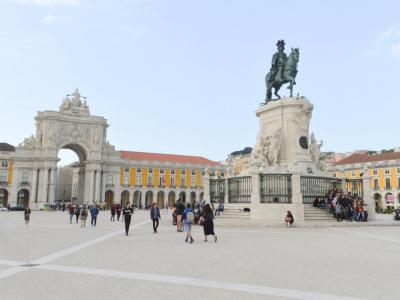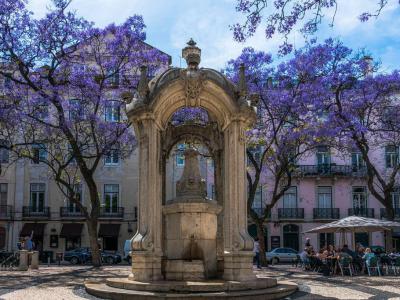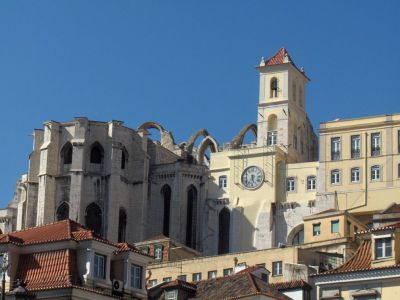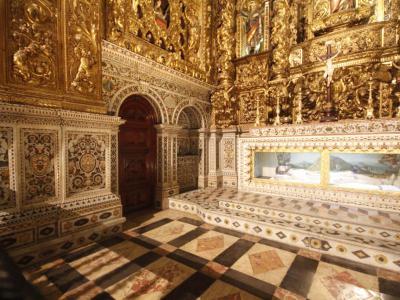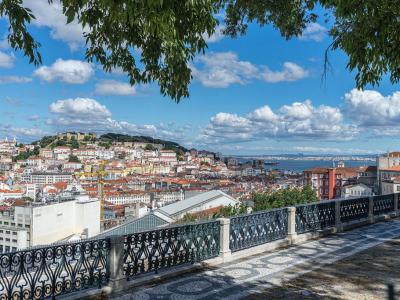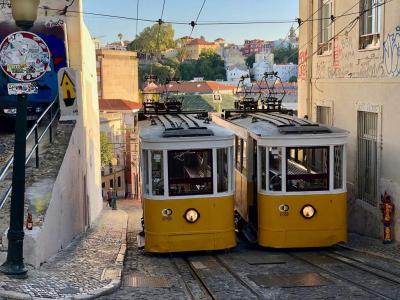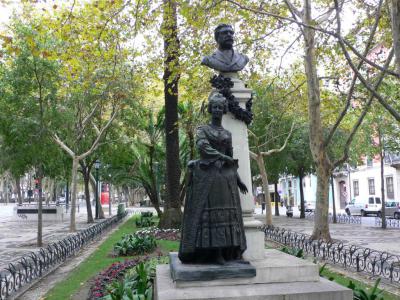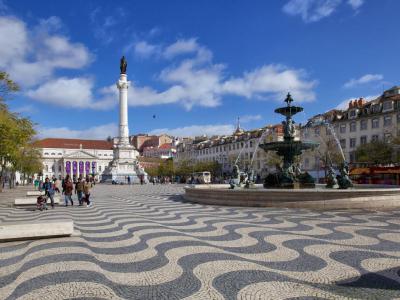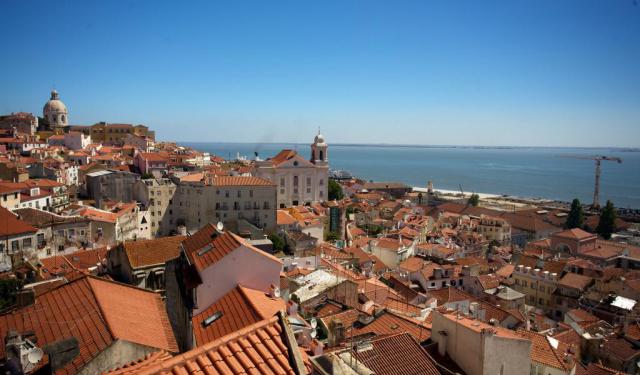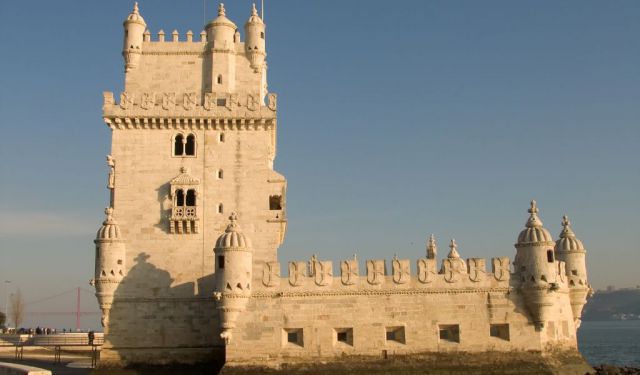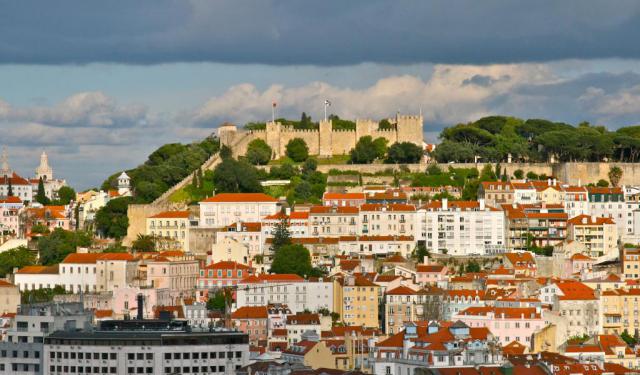Audio Guide: Lisbon Introduction Walking Tour (Self Guided), Lisbon
Lisbon, the capital city of Portugal, is a fascinating blend of history, culture, and breathtaking viewpoints. Its name is believed to have originated from the Phoenician term "Allis Ubbo", which means "safe harbor," reflecting the city's importance as a maritime hub since ancient times. Nestled at Europe's western edge and abundant in architectural styles, Lisbon ranks as the world's 10th oldest city, tracing its roots back to the Phoenician Civilization, which settled in the region approximately three millennia ago.
Over the centuries, the city has been shaped by the Greeks, Romans, Moors, and Portuguese explorers of the Age of Discovery, each leaving their cultural footprint visible today. The 1498 discovery of the sea route to India elevated Lisbon to a major trade hub. The devastating 1755 earthquake, tsunami, and fires reshaped the city, leading to the creation of the modern Baixa district. All these events have left lasting cultural and architectural legacies.
A great starting point to explore Lisbon is Commerce Square, a grand waterfront plaza, that once served as the bustling entry point for goods arriving by sea. From here, walk under the majestic Rua Augusta Arch to enter a lively pedestrian street buzzing with shops and cafés.
The Santa Justa Lift, a neo-Gothic marvel, connects the lower streets of Baixa with the higher Carmo district, where you can find the elegant Carmo Fountain and Square. Nearby, the Carmo Archaeological Museum, housed in the ruins of a Gothic church, offers a glimpse into Lisbon’s medieval history.
The Church of Saint Roch, one of the oldest Jesuit churches in the world, boasts an interior adorned with baroque splendor. For panoramic views of the city, head to the Sao Pedro Viewpoint, a serene terrace overlooking Lisbon’s iconic red rooftops and Saint George’s Castle looming majestically over the skyline.
To explore Lisbon’s hilly terrain, ride the charming Glória Funicular, which leads to the bustling Liberty Avenue, a boulevard lined with luxury shops and shaded walkways. Nearby, the Restorers Square and Rossio Square are hubs of activity, while Fig Tree Square offers a quieter corner to absorb the city’s rhythm.
Lisbon invites you to lose yourself in its maze of alleys, soak up the vibrant culture, and discover the charm of its timeless landmarks. Start planning your visit today and let this historic city captivate your senses.
Over the centuries, the city has been shaped by the Greeks, Romans, Moors, and Portuguese explorers of the Age of Discovery, each leaving their cultural footprint visible today. The 1498 discovery of the sea route to India elevated Lisbon to a major trade hub. The devastating 1755 earthquake, tsunami, and fires reshaped the city, leading to the creation of the modern Baixa district. All these events have left lasting cultural and architectural legacies.
A great starting point to explore Lisbon is Commerce Square, a grand waterfront plaza, that once served as the bustling entry point for goods arriving by sea. From here, walk under the majestic Rua Augusta Arch to enter a lively pedestrian street buzzing with shops and cafés.
The Santa Justa Lift, a neo-Gothic marvel, connects the lower streets of Baixa with the higher Carmo district, where you can find the elegant Carmo Fountain and Square. Nearby, the Carmo Archaeological Museum, housed in the ruins of a Gothic church, offers a glimpse into Lisbon’s medieval history.
The Church of Saint Roch, one of the oldest Jesuit churches in the world, boasts an interior adorned with baroque splendor. For panoramic views of the city, head to the Sao Pedro Viewpoint, a serene terrace overlooking Lisbon’s iconic red rooftops and Saint George’s Castle looming majestically over the skyline.
To explore Lisbon’s hilly terrain, ride the charming Glória Funicular, which leads to the bustling Liberty Avenue, a boulevard lined with luxury shops and shaded walkways. Nearby, the Restorers Square and Rossio Square are hubs of activity, while Fig Tree Square offers a quieter corner to absorb the city’s rhythm.
Lisbon invites you to lose yourself in its maze of alleys, soak up the vibrant culture, and discover the charm of its timeless landmarks. Start planning your visit today and let this historic city captivate your senses.
How it works: Download the app "GPSmyCity: Walks in 1K+ Cities" from Apple App Store or Google Play Store to your mobile phone or tablet. The app turns your mobile device into a personal tour guide and its built-in GPS navigation functions guide you from one tour stop to next. The app works offline, so no data plan is needed when traveling abroad.
Lisbon Introduction Walking Tour Map
Guide Name: Lisbon Introduction Walking Tour
Guide Location: Portugal » Lisbon (See other walking tours in Lisbon)
Guide Type: Self-guided Walking Tour (Sightseeing)
# of Attractions: 12
Tour Duration: 2 Hour(s)
Travel Distance: 2.4 Km or 1.5 Miles
Author: ray
Sight(s) Featured in This Guide:
Guide Location: Portugal » Lisbon (See other walking tours in Lisbon)
Guide Type: Self-guided Walking Tour (Sightseeing)
# of Attractions: 12
Tour Duration: 2 Hour(s)
Travel Distance: 2.4 Km or 1.5 Miles
Author: ray
Sight(s) Featured in This Guide:
- Praca do Comercio (Commerce Square)
- Arco da Rua Augusta (Augusta Street Arch)
- Elevador de Santa Justa (Santa Justa Lift)
- Chafariz do Carmo & Largo do Carmo (Carmo Fountain and Square)
- Museu Arqueologico do Carmo (Carmo Archaeological Museum)
- Igreja de Sao Roque (Church of St. Roch)
- Miradouro de Sao Pedro de Alcantara (Saint Peter's Viewpoint)
- Ascensor da Gloria (Gloria Funicular)
- Avenida da Liberdade (Liberty Avenue)
- Praca dos Restauradores (Restorers Square)
- Praca do Rossio (Rossio Square)
- Praca da Figueira (Fig Tree Square)
1) Praca do Comercio (Commerce Square) (must see)
Commerce Square in Lisbon is a landmark of historical and architectural significance. Spanning 30,600 square meters, this plaza is situated along the Tagus River and was once the site of the Royal Palace of Ribeira, which was destroyed in the 1755 Lisbon earthquake. This catastrophe also obliterated the royal archive, containing over 200,000 books and centuries of records.
The area's reconstruction was spearheaded by the Marquis of Pombal as part of his revitalization of the Baixa district. The result was a U-shaped layout with symmetrical government buildings flanking the square and opening towards the river. Its new occupants, customs and port authorities, gave rise to the square's new name – "Commerce." The design included ground-floor arcades and two towers inspired by the former Ribeira Palace.
At the center of the square stands an equestrian statue of King José I, unveiled in 1775. The statue honors the King’s role in rebuilding Lisbon and features motifs such as an elephant, symbolizing Portugal's colonial empire.
The plaza’s northern side is marked by the triumphal Augusta Street Arch. Completed in the 19th century, this arch celebrates Lisbon's resilience with sculptures of historical figures such as Vasco da Gama and the Marquis of Pombal.
Adjacent to the square is the Columns Pier. Its marble steps once served as a ceremonial entrance to the city during Portugal’s maritime era.
Tragedy touched the square in 1908 when King Carlos I and his heir Luís Filipe were assassinated here. This event presaged the fall of the Portuguese monarchy and the establishment of the Republic in 1910. Today, a plaque commemorates this pivotal moment in Portuguese history.
The western tower of Commerce Square contains a branch of the Museum of Lisbon.
The square itself is a vibrant hub of activity. Its arcades house souvenir shops, cafes, and Lisbon’s oldest café, Martinho da Arcada. Commerce Square hosts annual events like Portugal Day celebrations and offers visitors a chance to enjoy views of the Tagus River, the 25th of April Bridge, and passing ships. Accessible via trams and ferries, the plaza is both a historic site and a bustling meeting point for locals and tourists.
Tip:
For a glimpse of what the square looked like before the 1755 earthquake, you can find reproductions of contemporary engravings from the 17th and 18th centuries and a modern ceramic tile mural at the Santa Luzia Viewpoint in Alfama.
The area's reconstruction was spearheaded by the Marquis of Pombal as part of his revitalization of the Baixa district. The result was a U-shaped layout with symmetrical government buildings flanking the square and opening towards the river. Its new occupants, customs and port authorities, gave rise to the square's new name – "Commerce." The design included ground-floor arcades and two towers inspired by the former Ribeira Palace.
At the center of the square stands an equestrian statue of King José I, unveiled in 1775. The statue honors the King’s role in rebuilding Lisbon and features motifs such as an elephant, symbolizing Portugal's colonial empire.
The plaza’s northern side is marked by the triumphal Augusta Street Arch. Completed in the 19th century, this arch celebrates Lisbon's resilience with sculptures of historical figures such as Vasco da Gama and the Marquis of Pombal.
Adjacent to the square is the Columns Pier. Its marble steps once served as a ceremonial entrance to the city during Portugal’s maritime era.
Tragedy touched the square in 1908 when King Carlos I and his heir Luís Filipe were assassinated here. This event presaged the fall of the Portuguese monarchy and the establishment of the Republic in 1910. Today, a plaque commemorates this pivotal moment in Portuguese history.
The western tower of Commerce Square contains a branch of the Museum of Lisbon.
The square itself is a vibrant hub of activity. Its arcades house souvenir shops, cafes, and Lisbon’s oldest café, Martinho da Arcada. Commerce Square hosts annual events like Portugal Day celebrations and offers visitors a chance to enjoy views of the Tagus River, the 25th of April Bridge, and passing ships. Accessible via trams and ferries, the plaza is both a historic site and a bustling meeting point for locals and tourists.
Tip:
For a glimpse of what the square looked like before the 1755 earthquake, you can find reproductions of contemporary engravings from the 17th and 18th centuries and a modern ceramic tile mural at the Santa Luzia Viewpoint in Alfama.
2) Arco da Rua Augusta (Augusta Street Arch)
The Augusta Street Arch, located in Lisbon’s Commerce Plaza, is a historical landmark symbolizing the city’s reconstruction after the devastating 1755 earthquake. Originally envisioned as a bell tower, its design evolved into a grand triumphal arch over more than a century. The structure boasts six 11-meter-tall columns and a rich display of Portuguese historical and cultural motifs.
Atop the arch, a sculptural group symbolizes Glory bestowing laurel leaves upon Valor and Genius, alongside a bell that can be rung. The centerpiece, Glory, stands 7 meters tall, dressed in classical peplos, holding two crowns. Valor is personified by an Amazon figure with dragon-emblazoned armor, representing the Portuguese Royal House of Braganza. Genius, accompanied by a statue of Jupiter and symbols of writing and art, completes the trio. The arch’s height necessitated colossal proportions for these statues, enhancing their visual impact.
Four additional statues stand over the columns, honoring key figures in Portuguese history: the 14th-century general Nuno Álvares Pereira, 18th-century statesman Marquis of Pombal, Medieval Portuguese navigator and explorer Vasco da Gama, and Viriatus, a Lusitanian leader who fought against the Romans in the 2nd century BC. Reclining figures below symbolize the rivers Tagus and Douro, while inscriptions celebrate the Portuguese Empire's grandeur and achievements, including the phrase “To the Virtues of the Greatest, so that it may serve as a lesson to all. Dedicated at public expense.”
Since 2013, visitors can ascend the arch to enjoy panoramic views of Lisbon. A lift takes visitors most of the way, with additional steep stairs and stop-and-go traffic lights managing congestion. Informative displays on landings detail the arch’s history and the development of the area, including the story of an old clock.
Tip:
If you have the Lisbon Card, admission is free, and credit cards are accepted.
It's advisable to go early to avoid both the scorching heat and the crowds.
Atop the arch, a sculptural group symbolizes Glory bestowing laurel leaves upon Valor and Genius, alongside a bell that can be rung. The centerpiece, Glory, stands 7 meters tall, dressed in classical peplos, holding two crowns. Valor is personified by an Amazon figure with dragon-emblazoned armor, representing the Portuguese Royal House of Braganza. Genius, accompanied by a statue of Jupiter and symbols of writing and art, completes the trio. The arch’s height necessitated colossal proportions for these statues, enhancing their visual impact.
Four additional statues stand over the columns, honoring key figures in Portuguese history: the 14th-century general Nuno Álvares Pereira, 18th-century statesman Marquis of Pombal, Medieval Portuguese navigator and explorer Vasco da Gama, and Viriatus, a Lusitanian leader who fought against the Romans in the 2nd century BC. Reclining figures below symbolize the rivers Tagus and Douro, while inscriptions celebrate the Portuguese Empire's grandeur and achievements, including the phrase “To the Virtues of the Greatest, so that it may serve as a lesson to all. Dedicated at public expense.”
Since 2013, visitors can ascend the arch to enjoy panoramic views of Lisbon. A lift takes visitors most of the way, with additional steep stairs and stop-and-go traffic lights managing congestion. Informative displays on landings detail the arch’s history and the development of the area, including the story of an old clock.
Tip:
If you have the Lisbon Card, admission is free, and credit cards are accepted.
It's advisable to go early to avoid both the scorching heat and the crowds.
3) Elevador de Santa Justa (Santa Justa Lift) (must see)
The Santa Justa Lift, also known as the Carmo Lift, is a distinctive attraction in Lisbon. This historic elevator, built in the early 20th century, is the only remaining vertical lift in the capital. Others, such as the Glória and Bica lifts, are funicular railways. This lift was designed to address the city's challenging terrain, linking the lower Baixa district to the elevated Carmo Square. Construction began in 1900, and the lift was inaugurated in 1901, initially operating on steam power before transitioning to electricity in 1907.
The Neo-Gothic iron structure, 45 meters tall, features intricate metalwork, a double-lattice design, and two wood-paneled cabins that transport passengers across seven stories. Originally accommodating 24 people, the cabins were later upgraded to hold 29 passengers. A spiral staircase and walkway connect the lift to nearby attractions, offering panoramic views of landmarks, such as Saint George's Castle, the Tagus River, Rossio Square, and the Baixa district, from its observation deck.
Designated a National Monument in 2002, the Santa Justa Lift underwent renovations to preserve its historical significance and was reopened to the public in 2006. It remains a vital link and a tourist attraction, embodying innovative engineering from its era. Visitors also use the lift to access key sites like Carmo Square, Saint Roch Church, and the Bairro Alto neighborhood.
Tip:
It's important to note that ascending the iron spiral staircase requires a head for heights. However, if you can conquer any nervousness, the views are truly spectacular and well worth the effort. Additionally, keep in mind that the top platform is quite exposed, so it's advisable to check the weather conditions before planning your visit.
If you find the queue too long, consider entering the cork store on Rua do Carmo, ascending the stairs, and then crossing the street via the walkway. Although this option requires physical effort to climb the stairs, it saves time and money while allowing for more opportunities to savor the views along the way.
The Neo-Gothic iron structure, 45 meters tall, features intricate metalwork, a double-lattice design, and two wood-paneled cabins that transport passengers across seven stories. Originally accommodating 24 people, the cabins were later upgraded to hold 29 passengers. A spiral staircase and walkway connect the lift to nearby attractions, offering panoramic views of landmarks, such as Saint George's Castle, the Tagus River, Rossio Square, and the Baixa district, from its observation deck.
Designated a National Monument in 2002, the Santa Justa Lift underwent renovations to preserve its historical significance and was reopened to the public in 2006. It remains a vital link and a tourist attraction, embodying innovative engineering from its era. Visitors also use the lift to access key sites like Carmo Square, Saint Roch Church, and the Bairro Alto neighborhood.
Tip:
It's important to note that ascending the iron spiral staircase requires a head for heights. However, if you can conquer any nervousness, the views are truly spectacular and well worth the effort. Additionally, keep in mind that the top platform is quite exposed, so it's advisable to check the weather conditions before planning your visit.
If you find the queue too long, consider entering the cork store on Rua do Carmo, ascending the stairs, and then crossing the street via the walkway. Although this option requires physical effort to climb the stairs, it saves time and money while allowing for more opportunities to savor the views along the way.
4) Chafariz do Carmo & Largo do Carmo (Carmo Fountain and Square)
The serene and historically rich Carmo Square in Lisbon is celebrated for its tranquil atmosphere and shaded jacaranda trees. Unlike Lisbon’s grander squares, it offers a peaceful escape from the bustling tourist paths, complemented by notable monuments and inviting open-air restaurants.
The plaza is anchored by the striking ruins of the Church of Our Lady of Mount Carmel, remnants of a once-magnificent Gothic temple devastated by the 1755 earthquake. The skeletal arches stand as a poignant reminder of the disaster, contrasting sharply with the vibrant surroundings. Within the church’s ruins lies the Carmo Archaeological Museum, one of Portugal's first archaeology museums, established to safeguard valuable artifacts.
Adjacent to the convent, the Carmo Barracks holds significant historical importance as the site where Portugal's last dictator, Marcello Caetano, officially relinquished power during the 1974 Carnation Revolution. A commemorative plaque marks this pivotal event in Portuguese history. The convent itself now serves as the headquarters of the National Republican Guard and houses a small museum detailing the history of Portugal’s paramilitary security forces.
The Carmo Fountain, now purely decorative, was originally built atop an aqueduct that supplied water to the area. Today, it adds a great deal of charm to the plaza, making it a favored spot for alfresco dining. This late Baroque fountain is one of the many public fountains constructed in Lisbon during the 15th through 18th centuries. It is characterized by a structure enclosed within an elegant porch supported by four grand pillars.
Nearby, the Santa Justa Lift connects the plaza to the Baixa district, offering panoramic views of the city.
The plaza also features the Valadares Palace and inviting esplanades perfect for a leisurely stroll. Its cinematic beauty, enhanced by blooming jacaranda trees, has made it a popular setting for films and documentaries.
Additionally, Carmo Square boasts some of the city's finest restaurants with outdoor seating, creating an excellent dining experience. Visitors can also enjoy the cozy, circular kiosk café, where musicians often provide entertainment. On Sundays, there's even a small market to explore.
The plaza is anchored by the striking ruins of the Church of Our Lady of Mount Carmel, remnants of a once-magnificent Gothic temple devastated by the 1755 earthquake. The skeletal arches stand as a poignant reminder of the disaster, contrasting sharply with the vibrant surroundings. Within the church’s ruins lies the Carmo Archaeological Museum, one of Portugal's first archaeology museums, established to safeguard valuable artifacts.
Adjacent to the convent, the Carmo Barracks holds significant historical importance as the site where Portugal's last dictator, Marcello Caetano, officially relinquished power during the 1974 Carnation Revolution. A commemorative plaque marks this pivotal event in Portuguese history. The convent itself now serves as the headquarters of the National Republican Guard and houses a small museum detailing the history of Portugal’s paramilitary security forces.
The Carmo Fountain, now purely decorative, was originally built atop an aqueduct that supplied water to the area. Today, it adds a great deal of charm to the plaza, making it a favored spot for alfresco dining. This late Baroque fountain is one of the many public fountains constructed in Lisbon during the 15th through 18th centuries. It is characterized by a structure enclosed within an elegant porch supported by four grand pillars.
Nearby, the Santa Justa Lift connects the plaza to the Baixa district, offering panoramic views of the city.
The plaza also features the Valadares Palace and inviting esplanades perfect for a leisurely stroll. Its cinematic beauty, enhanced by blooming jacaranda trees, has made it a popular setting for films and documentaries.
Additionally, Carmo Square boasts some of the city's finest restaurants with outdoor seating, creating an excellent dining experience. Visitors can also enjoy the cozy, circular kiosk café, where musicians often provide entertainment. On Sundays, there's even a small market to explore.
5) Museu Arqueologico do Carmo (Carmo Archaeological Museum) (must see)
Located in Lisbon's Chiado neighborhood, overlooking Rossio Square, the Convent of Our Lady of Mount Carmel is both a historical landmark and a cultural treasure, as well as a lasting reminder of the devastation caused by the 1755 earthquake. Founded in 1389, the convent housed Carmelite friars up to 1423. It flourished in the 16th century, with 70 clergy residing within its walls.
The 1755 earthquake destroyed the convent’s library of 5,000 volumes and caused severe structural damage, leaving its Gothic church in ruins. Following minor repairs undertaken in the 19th century, the building saw various uses, including as police quarters, a sawmill, and later a military station. In 1834, the site transitioned to secular use after religious orders were expelled from Portugal.
In 1864, the Association of Portuguese Archaeologists took ownership, transforming the ruined convent into a museum. Efforts to restore the site continued into the 20th century, with significant work undertaken in 1902 and the 1950s. However, the structure sustained further damage in the 1969 earthquake. Five years later, the convent played a key role in Portugal's Carnation Revolution, serving as a stronghold for the Estado Novo regime before its surrender to pro-democracy forces.
Architecturally, the Carmo Convent showcases Gothic design. Its church, featuring a Latin cross layout, includes a partially destroyed rose window and surviving pointed arches. The stone roof collapsed during the 1755 earthquake and was never rebuilt, giving the church its unique open-air appearance.
Today, the convent is home to the Carmo Archaeological Museum, displaying artifacts spanning Portuguese history. The museum houses Gothic tombs, Roman and Visigoth objects, and Moorish painted tin-glazed ceramic tilework. The former apse chapels have been repurposed as exhibition spaces, with one of them displaying remarkable pre-historic relics excavated from an ancient fortification dating from 3500 to 1500 BC.
The entrance fee is reasonable, and there is much to explore, including a well-executed multimedia presentation recounting the site's history. You'll need about 80-90 minutes to get a comprehensive look, though you might want to save some extra time for the surrounding terraces, offering splendid vistas of the Castle of the Moors.
Tip:
If you're looking for a way to get back down the hill into the city, your best bet is to take the Santa Justa Lift. Located just to the right of the convent, it is accessible via a footbridge through the Bellalisa Restaurant.
The 1755 earthquake destroyed the convent’s library of 5,000 volumes and caused severe structural damage, leaving its Gothic church in ruins. Following minor repairs undertaken in the 19th century, the building saw various uses, including as police quarters, a sawmill, and later a military station. In 1834, the site transitioned to secular use after religious orders were expelled from Portugal.
In 1864, the Association of Portuguese Archaeologists took ownership, transforming the ruined convent into a museum. Efforts to restore the site continued into the 20th century, with significant work undertaken in 1902 and the 1950s. However, the structure sustained further damage in the 1969 earthquake. Five years later, the convent played a key role in Portugal's Carnation Revolution, serving as a stronghold for the Estado Novo regime before its surrender to pro-democracy forces.
Architecturally, the Carmo Convent showcases Gothic design. Its church, featuring a Latin cross layout, includes a partially destroyed rose window and surviving pointed arches. The stone roof collapsed during the 1755 earthquake and was never rebuilt, giving the church its unique open-air appearance.
Today, the convent is home to the Carmo Archaeological Museum, displaying artifacts spanning Portuguese history. The museum houses Gothic tombs, Roman and Visigoth objects, and Moorish painted tin-glazed ceramic tilework. The former apse chapels have been repurposed as exhibition spaces, with one of them displaying remarkable pre-historic relics excavated from an ancient fortification dating from 3500 to 1500 BC.
The entrance fee is reasonable, and there is much to explore, including a well-executed multimedia presentation recounting the site's history. You'll need about 80-90 minutes to get a comprehensive look, though you might want to save some extra time for the surrounding terraces, offering splendid vistas of the Castle of the Moors.
Tip:
If you're looking for a way to get back down the hill into the city, your best bet is to take the Santa Justa Lift. Located just to the right of the convent, it is accessible via a footbridge through the Bellalisa Restaurant.
6) Igreja de Sao Roque (Church of St. Roch)
The Church of Saint Roch in Lisbon, built in the 16th century, is one of the earliest Jesuit churches globally and the first in the Portuguese world. Renowned for its role in pioneering the "auditorium-church" style for preaching, it served as the principal church for the Jesuits in Portugal for over two centuries. Despite the Jesuits’ expulsion in 1759, the church was preserved and entrusted to the Lisbon Holy House of Mercy in 1768, which continues to manage it today.
The church has a fascinating origin tied to a devastating plague in 1505, prompting King Manuel I to acquire a relic of Saint Roch, the patron saint of plague victims, from Venice. Initially housed in a shrine built by locals in Bairro Alto, the Jesuits took over in 1553 and constructed the current church by 1575, designed by royal architects. The structure, a rare survivor of the 1755 earthquake, combines a simple Jesuit-style exterior with a richly adorned interior.
Inside, the church dazzles with gilded altars, intricate marble and alabaster designs, and precious stones like amethyst and lapis lazuli. Its Baroque chapels, especially the 18th-century Chapel of Saint John the Baptist, stand out. This masterpiece, commissioned by King John V, was crafted in Rome using precious marble and mosaics before being transported to Lisbon. The interior reflects evolving styles from Mannerism to Baroque, showcasing exquisite “azulejo” tiles, statues, and trompe-l'œil ceiling depicting Biblical scenes and the life of Saint Ignatius of Loyola, a venerated Basque Spaniard Catholic priest.
The church features a chancel, eight chapels, and additional altars in the transepts, each highlighting different historical and artistic periods. The museum within the church preserves artifacts and provides insight into its rich history.
Tip:
If you have the luxury of time, consider exploring the in-house museum, where you'll find two floors filled with artworks, antiquities, reliquaries, and other valuable possessions collected over centuries by the church. On Sundays until 2 pm, the entry is free. Among the most precious items, there are the treasures originally situated in the Chapel of Saint John the Baptist within the church nave.
The church has a fascinating origin tied to a devastating plague in 1505, prompting King Manuel I to acquire a relic of Saint Roch, the patron saint of plague victims, from Venice. Initially housed in a shrine built by locals in Bairro Alto, the Jesuits took over in 1553 and constructed the current church by 1575, designed by royal architects. The structure, a rare survivor of the 1755 earthquake, combines a simple Jesuit-style exterior with a richly adorned interior.
Inside, the church dazzles with gilded altars, intricate marble and alabaster designs, and precious stones like amethyst and lapis lazuli. Its Baroque chapels, especially the 18th-century Chapel of Saint John the Baptist, stand out. This masterpiece, commissioned by King John V, was crafted in Rome using precious marble and mosaics before being transported to Lisbon. The interior reflects evolving styles from Mannerism to Baroque, showcasing exquisite “azulejo” tiles, statues, and trompe-l'œil ceiling depicting Biblical scenes and the life of Saint Ignatius of Loyola, a venerated Basque Spaniard Catholic priest.
The church features a chancel, eight chapels, and additional altars in the transepts, each highlighting different historical and artistic periods. The museum within the church preserves artifacts and provides insight into its rich history.
Tip:
If you have the luxury of time, consider exploring the in-house museum, where you'll find two floors filled with artworks, antiquities, reliquaries, and other valuable possessions collected over centuries by the church. On Sundays until 2 pm, the entry is free. Among the most precious items, there are the treasures originally situated in the Chapel of Saint John the Baptist within the church nave.
7) Miradouro de Sao Pedro de Alcantara (Saint Peter's Viewpoint) (must see)
The Garden of Saint Peter of Alcantara is a picturesque viewpoint in central Lisbon, offering panoramic views of the Baixa and Mouraria neighborhoods, with the iconic Saint George's Castle prominently in sight.
Divided into two terraces, the garden caters to diverse experiences. The upper terrace features a lively atmosphere with musicians, pop-up bars, and a charming fountain alongside a monument to Eduardo Coelho, founder of the local Daily News paper, and a statue of a newsboy, reflecting Bairro Alto’s printing heritage. In contrast, the lower terrace offers a serene retreat, adorned with flower beds, sculptures of Greek and Roman figures like Minerva and Ulysses, and a small waterfall.
Historically, the garden traces its roots to a 17th-century aqueduct project, later interrupted by the 1755 earthquake. The centerpiece Baroque fountain, relocated from Bemposta Palace, adds to its historical charm. The garden acts as a crossroads, linking the historic Baixa district, the upscale Príncipe Real and the lively Bairro Alto neighborhoods, blending elements of history, class, and social vibrancy.
Visitors can relax on benches, enjoy local music, or indulge in food and drinks from nearby stalls. Across the street, the Port Wine Institute offers over 300 varieties of Port wine, perfect for a cozy tasting or a waterside picnic. Dynamic street art at the Urban Art Gallery adds a contemporary flair.
Accessibility is enhanced by the Glória Lift, a vintage funicular connecting the garden to Restorers Square, bypassing a steep hill. The traditional Miradouro bar and the nearby Lumi Rooftop offer further refreshment and dining options. A unique 1952 tile map in the garden helps visitors identify Lisbon’s landmarks, enhancing their exploration of the city.
With its blend of history, culture, and scenic beauty, the Garden of Saint Peter of Alcantara is a must-visit spot for anyone exploring Lisbon.
Divided into two terraces, the garden caters to diverse experiences. The upper terrace features a lively atmosphere with musicians, pop-up bars, and a charming fountain alongside a monument to Eduardo Coelho, founder of the local Daily News paper, and a statue of a newsboy, reflecting Bairro Alto’s printing heritage. In contrast, the lower terrace offers a serene retreat, adorned with flower beds, sculptures of Greek and Roman figures like Minerva and Ulysses, and a small waterfall.
Historically, the garden traces its roots to a 17th-century aqueduct project, later interrupted by the 1755 earthquake. The centerpiece Baroque fountain, relocated from Bemposta Palace, adds to its historical charm. The garden acts as a crossroads, linking the historic Baixa district, the upscale Príncipe Real and the lively Bairro Alto neighborhoods, blending elements of history, class, and social vibrancy.
Visitors can relax on benches, enjoy local music, or indulge in food and drinks from nearby stalls. Across the street, the Port Wine Institute offers over 300 varieties of Port wine, perfect for a cozy tasting or a waterside picnic. Dynamic street art at the Urban Art Gallery adds a contemporary flair.
Accessibility is enhanced by the Glória Lift, a vintage funicular connecting the garden to Restorers Square, bypassing a steep hill. The traditional Miradouro bar and the nearby Lumi Rooftop offer further refreshment and dining options. A unique 1952 tile map in the garden helps visitors identify Lisbon’s landmarks, enhancing their exploration of the city.
With its blend of history, culture, and scenic beauty, the Garden of Saint Peter of Alcantara is a must-visit spot for anyone exploring Lisbon.
8) Ascensor da Gloria (Gloria Funicular)
The Glória Funicular, also known as the Glória Lift, is a historic funicular railway in Lisbon's Santo António parish. Instead of viewing this as merely a tourist attraction, consider it an extraordinary engineering achievement!
The funicular connects Restorers Square in the downtown Pombaline district to the Bairro Alto neighborhood, specifically the Saint Peter of Alcântara Garden and Viewpoint. Operating on a counterweight principle, the system features two partially wooden streetcars linked by a cable, enabling simultaneous ascent and descent. Uniquely, electric motors on the cars, powered by overhead wires, provide traction.
The funicular's history dates back to 1875 when the New Lisbon Mechanical Lift Company received a concession to build it. Construction began in 1882, and the lift opened on 24 October 1885. Initially water-powered, it switched to steam by 1886 and then to electricity in 1915. The original design included two-tiered cars with seating arranged back-to-back on the upper floor and inward-facing benches on the lower.
In 1995, the line's operator proposed its heritage classification, leading to its designation as a National Monument two years later.
The funicular operates on a 17.7% slope of about 900 feet (or 270 meters). The inclined trams are designed for passenger comfort, with longitudinally arranged seats to maintain a level perspective. The tram journey typically lasts about 2-3 minutes, while an on-foot descent along the track takes anywhere between 5 and 8 minutes, depending on one's age and physical stamina.
Whatever you choose, the route will pass through one of Lisbon's finest showcases of neighborhood graffiti, predominantly on the right side (when going uphill), as this built-up 19th-century area is officially dedicated to sanctioned street art. Additionally, it features landmarks like the Foz Palace and the Misericórdia district.
Today, the Glória Funicular remains a cherished piece of Lisbon's history and an entertaining mode of public transportation, particularly for those unfamiliar with the charm of funicular trams. There are excellent photo opportunities from the summit, making it an excellent point for exploring the Bairro Alto neighborhood.
The funicular connects Restorers Square in the downtown Pombaline district to the Bairro Alto neighborhood, specifically the Saint Peter of Alcântara Garden and Viewpoint. Operating on a counterweight principle, the system features two partially wooden streetcars linked by a cable, enabling simultaneous ascent and descent. Uniquely, electric motors on the cars, powered by overhead wires, provide traction.
The funicular's history dates back to 1875 when the New Lisbon Mechanical Lift Company received a concession to build it. Construction began in 1882, and the lift opened on 24 October 1885. Initially water-powered, it switched to steam by 1886 and then to electricity in 1915. The original design included two-tiered cars with seating arranged back-to-back on the upper floor and inward-facing benches on the lower.
In 1995, the line's operator proposed its heritage classification, leading to its designation as a National Monument two years later.
The funicular operates on a 17.7% slope of about 900 feet (or 270 meters). The inclined trams are designed for passenger comfort, with longitudinally arranged seats to maintain a level perspective. The tram journey typically lasts about 2-3 minutes, while an on-foot descent along the track takes anywhere between 5 and 8 minutes, depending on one's age and physical stamina.
Whatever you choose, the route will pass through one of Lisbon's finest showcases of neighborhood graffiti, predominantly on the right side (when going uphill), as this built-up 19th-century area is officially dedicated to sanctioned street art. Additionally, it features landmarks like the Foz Palace and the Misericórdia district.
Today, the Glória Funicular remains a cherished piece of Lisbon's history and an entertaining mode of public transportation, particularly for those unfamiliar with the charm of funicular trams. There are excellent photo opportunities from the summit, making it an excellent point for exploring the Bairro Alto neighborhood.
9) Avenida da Liberdade (Liberty Avenue)
Liberty Avenue, a central boulevard in Lisbon, is renowned as one of Europe's most prestigious and expensive streets. Its history dates back to the 18th century, originating as a park for Portuguese nobility. Transformed into a boulevard between 1879 and 1886, the avenue marked Lisbon's northward expansion, modeled after the grand boulevards of Paris. It connects the Marquis of Pombal Square, also known as the Rotunda, in the north to Restorers Square, which is the gateway to Lisbon's Baixa district.
The avenue retains elements of its original park, including statues representing the Tagus and Douro rivers, fountains, and a waterfall from the 1830s. Following this, you'll encounter landscaped garden areas enclosed by four marble statues symbolizing Europe, Africa, Asia, and Oceania.
In recent decades, many historic buildings in the area were replaced by modern offices and hotels. Despite this, the avenue is still adorned with multiple monuments, including tributes to the Portuguese poet and politician Almeida Garrett, novelist and historian Alexandre Herculano, and a 1931 World War I memorial.
Today, Liberty Avenue is a hub of luxury. Towards its upper stretch, housing some of Lisbon's most upscale real estate, you'll find a concentration of international high-end brands such as Louis Vuitton, Prada, Dior, Chanel, and Gucci. Its central location places it near prominent landmarks like Eduardo VII Park, Queen Maria II National Theatre, and the Avenidas Novas district.
The avenue is also a destination for luxury hotels, including those from Sofitel, Tivoli Hotels & Resorts, and Dom Pedro Hotels. Additionally, it is home to several cinemas and numerous cafes and patisseries. During the summer months, some of these establishments extend their services into the well-lit central gardens, creating a lively evening atmosphere enriched with music.
As a prestigious address in Lisbon, Liberty Avenue blends historical significance with modern elegance, serving as a symbol of the city's cultural and economic vitality.
The avenue retains elements of its original park, including statues representing the Tagus and Douro rivers, fountains, and a waterfall from the 1830s. Following this, you'll encounter landscaped garden areas enclosed by four marble statues symbolizing Europe, Africa, Asia, and Oceania.
In recent decades, many historic buildings in the area were replaced by modern offices and hotels. Despite this, the avenue is still adorned with multiple monuments, including tributes to the Portuguese poet and politician Almeida Garrett, novelist and historian Alexandre Herculano, and a 1931 World War I memorial.
Today, Liberty Avenue is a hub of luxury. Towards its upper stretch, housing some of Lisbon's most upscale real estate, you'll find a concentration of international high-end brands such as Louis Vuitton, Prada, Dior, Chanel, and Gucci. Its central location places it near prominent landmarks like Eduardo VII Park, Queen Maria II National Theatre, and the Avenidas Novas district.
The avenue is also a destination for luxury hotels, including those from Sofitel, Tivoli Hotels & Resorts, and Dom Pedro Hotels. Additionally, it is home to several cinemas and numerous cafes and patisseries. During the summer months, some of these establishments extend their services into the well-lit central gardens, creating a lively evening atmosphere enriched with music.
As a prestigious address in Lisbon, Liberty Avenue blends historical significance with modern elegance, serving as a symbol of the city's cultural and economic vitality.
10) Praca dos Restauradores (Restorers Square)
The elongated Restorers Square, situated at the southeastern terminus of Liberty Avenue, derives its name from the momentous reinstatement of Portugal's independence in 1640, following 60 years of Spanish rule. Inaugurated in 1886, a prominent obelisk at its center commemorates the battles waged during the Portuguese Restoration War, with statues symbolizing Independence and Victory.
Distinguished by the iconic patterned tiles characteristic of Lisbon, this square is encircled by architectural gems from the 19th and early 20th centuries. Among these, Foz Palace stands out, a pink mansion that once served as the Ministry of Propaganda during the Salazar regime (from 1932 to 1974). Today, it houses the Portuguese Tourist Office, where you can conveniently purchase your Lisboa Card. Additionally, the palace's Hall of Mirrors hosts free public concerts.
Other noteworthy landmarks include the former Éden Cinema, now transformed into a hotel, adorned with a splendid Art Deco façade dating to the 1930s. The former Condes Cinema, built in a Modernist style in 1950, now hosts Lisbon's Hard Rock Cafe. Beyond that, don't miss the splendid fountain, which provides an excellent backdrop for photography and is particularly selfie-friendly.
Tip:
North of the square, the Glória Funicular offers convenient access to the Bairro Alto neighborhood.
Distinguished by the iconic patterned tiles characteristic of Lisbon, this square is encircled by architectural gems from the 19th and early 20th centuries. Among these, Foz Palace stands out, a pink mansion that once served as the Ministry of Propaganda during the Salazar regime (from 1932 to 1974). Today, it houses the Portuguese Tourist Office, where you can conveniently purchase your Lisboa Card. Additionally, the palace's Hall of Mirrors hosts free public concerts.
Other noteworthy landmarks include the former Éden Cinema, now transformed into a hotel, adorned with a splendid Art Deco façade dating to the 1930s. The former Condes Cinema, built in a Modernist style in 1950, now hosts Lisbon's Hard Rock Cafe. Beyond that, don't miss the splendid fountain, which provides an excellent backdrop for photography and is particularly selfie-friendly.
Tip:
North of the square, the Glória Funicular offers convenient access to the Bairro Alto neighborhood.
11) Praca do Rossio (Rossio Square)
The King Pedro IV Square, commonly known as Rossio, is a historic square in Lisbon’s Pombaline Downtown. Dating back to the Middle Ages, it has been a central site for public life, hosting events, from celebrations and revolts to bullfights and executions. The square’s centerpiece, the Column of Pedro IV, honors the Portuguese king for whom it is named.
Rossio became prominent in the 13th and 14th centuries as Lisbon expanded. Its colloquial name derives from the Portuguese term for "commons," reflecting its origins as communal land. In the 15th century, the Palace of Estaus was built on its northern side to house visiting dignitaries. Later, it became the headquarters of the Inquisition, and the square hosted public executions, including the first ritual of public penance, known as the “act of faith,” in 1540. On its eastern side, the All Saints Royal Hospital was constructed in 1504 but was destroyed in the 1755 earthquake, which devastated most of Lisbon. The earthquake spared only the Palace of Independence near the northeast corner, where Portuguese noblemen plotted against Spanish rule in 1640.
The post-earthquake reconstruction of Rossio defined its Pombaline architectural style. The Bandeira Arch, on the south side, connects Rossio to nearby streets like Rua Augusta and Commerce Square. The 19th century brought further transformation, with the Queen Maria II National Theatre replacing the infamous Inquisition Palace demolished in 1836. Designed in a neoclassical style, the theater features a statue of playwright Gil Vicente, a figure once censored by the Inquisition.
In the 19th century, Rossio gained its famous Portuguese wavelike mosaic pavement and two baroque bronze fountains situated at its southern and northern perimeters. The Rossio Train Station, built in 1887 with a neo-Manueline façade and striking horseshoe entry arches, added a grand feature to the northwest side. Cafés like Café Nicola and shops such as Ginjinha (selling the local sweet cherry liqueur) have made the square a popular social hub, attracting both locals and tourists.
Other noteworthy attractions nearby include the historic Santo Domingo Square, featuring a church, a memorial commemorating the Jewish victims of the 1506 massacre, and the neighboring Fig Tree Square. To the left of the theater, you'll find the Hotel Avenida Palace and Carmo Street, among other prominent landmarks. Finally, just behind the theater, the Gates of Santo Antão Street awaits, renowned as a famous "food street" replete with numerous cafes and restaurants.
Rossio became prominent in the 13th and 14th centuries as Lisbon expanded. Its colloquial name derives from the Portuguese term for "commons," reflecting its origins as communal land. In the 15th century, the Palace of Estaus was built on its northern side to house visiting dignitaries. Later, it became the headquarters of the Inquisition, and the square hosted public executions, including the first ritual of public penance, known as the “act of faith,” in 1540. On its eastern side, the All Saints Royal Hospital was constructed in 1504 but was destroyed in the 1755 earthquake, which devastated most of Lisbon. The earthquake spared only the Palace of Independence near the northeast corner, where Portuguese noblemen plotted against Spanish rule in 1640.
The post-earthquake reconstruction of Rossio defined its Pombaline architectural style. The Bandeira Arch, on the south side, connects Rossio to nearby streets like Rua Augusta and Commerce Square. The 19th century brought further transformation, with the Queen Maria II National Theatre replacing the infamous Inquisition Palace demolished in 1836. Designed in a neoclassical style, the theater features a statue of playwright Gil Vicente, a figure once censored by the Inquisition.
In the 19th century, Rossio gained its famous Portuguese wavelike mosaic pavement and two baroque bronze fountains situated at its southern and northern perimeters. The Rossio Train Station, built in 1887 with a neo-Manueline façade and striking horseshoe entry arches, added a grand feature to the northwest side. Cafés like Café Nicola and shops such as Ginjinha (selling the local sweet cherry liqueur) have made the square a popular social hub, attracting both locals and tourists.
Other noteworthy attractions nearby include the historic Santo Domingo Square, featuring a church, a memorial commemorating the Jewish victims of the 1506 massacre, and the neighboring Fig Tree Square. To the left of the theater, you'll find the Hotel Avenida Palace and Carmo Street, among other prominent landmarks. Finally, just behind the theater, the Gates of Santo Antão Street awaits, renowned as a famous "food street" replete with numerous cafes and restaurants.
12) Praca da Figueira (Fig Tree Square)
Fig Tree Square in Lisbon's Baixa district embodies the city’s transformation since the catastrophic 1755 earthquake. Once the site of Lisbon’s main hospital, the area was reimagined by the Marquis of Pombal as an open-air market after the hospital's demolition. Known initially as Herb Square and later New Square, it developed into a vibrant trade hub, gradually enhanced with trees, lighting, and iron railings. By 1885, it featured an impressive 8,000-square-meter iron-covered market that became the heart of city life for over six decades until its demolition in 1949.
Modern renovations brought significant changes to the area, including the construction of uniform Pombaline-style four-story buildings that now house hotels, shops, and bustling cafés. Notable establishments like FIGUS and BASTARDO are known for their exceptional service, high-quality dishes, and innovative cocktails, attracting both locals and visitors. The introduction of the metro in the 1960s further enhanced the square’s accessibility.
In 1971, a bronze equestrian statue of King João I was installed here, celebrating the monarch's long reign (48 years-the longest in Portuguese monarch history) and pivotal role in Portugal's global expansion. Medallions on the statue honor key figures of the 1385 Revolution. During renovations in 1999-2000, the statue was moved to improve its visibility from Commerce Square.
Today, Fig Tree Square remains a lively hub with its smaller open-air Baixa Market, offering Portuguese culinary delights, beverages, and authentic merchandise. Its cafés, shops, and historical charm make it an ideal spot for a break, whether to enjoy refreshing sangria or explore the square’s enduring connection to Lisbon’s vibrant past.
Modern renovations brought significant changes to the area, including the construction of uniform Pombaline-style four-story buildings that now house hotels, shops, and bustling cafés. Notable establishments like FIGUS and BASTARDO are known for their exceptional service, high-quality dishes, and innovative cocktails, attracting both locals and visitors. The introduction of the metro in the 1960s further enhanced the square’s accessibility.
In 1971, a bronze equestrian statue of King João I was installed here, celebrating the monarch's long reign (48 years-the longest in Portuguese monarch history) and pivotal role in Portugal's global expansion. Medallions on the statue honor key figures of the 1385 Revolution. During renovations in 1999-2000, the statue was moved to improve its visibility from Commerce Square.
Today, Fig Tree Square remains a lively hub with its smaller open-air Baixa Market, offering Portuguese culinary delights, beverages, and authentic merchandise. Its cafés, shops, and historical charm make it an ideal spot for a break, whether to enjoy refreshing sangria or explore the square’s enduring connection to Lisbon’s vibrant past.
Walking Tours in Lisbon, Portugal
Create Your Own Walk in Lisbon
Creating your own self-guided walk in Lisbon is easy and fun. Choose the city attractions that you want to see and a walk route map will be created just for you. You can even set your hotel as the start point of the walk.
Alfama Walking Tour
Alfama, the oldest district of Lisbon, spreads downhill along the Tagus River. It retains a charmingly labyrinthine layout with narrow alleys and steep streets. Under Islamic rule, this part of the city was increasingly inhabited by fishermen and the poor. The reputation of being a poor area still lives on. The name Alfama derives from the Arabic al-ḥamma, which means "hot fountains"... view more
Tour Duration: 2 Hour(s)
Travel Distance: 3.0 Km or 1.9 Miles
Tour Duration: 2 Hour(s)
Travel Distance: 3.0 Km or 1.9 Miles
Belem Walking Tour
Also known as Santa Maria de Belem, the district of Belem is one of the most visited in Lisbon. Situated not far from the city center, it lines the Tagus River and is the original location of Lisbon's port – the starting point of the many great voyages of discovery by Portuguese explorers, such as Vasco da Gama – departed from here for India in 1497, and Pedro Alvares Cabral – for... view more
Tour Duration: 2 Hour(s)
Travel Distance: 3.0 Km or 1.9 Miles
Tour Duration: 2 Hour(s)
Travel Distance: 3.0 Km or 1.9 Miles
Sao Jorge Castle to Lisbon Cathedral Walking Tour
Spreading on the slope between Saint George's Castle (Castelo de Sao Jorge) and the Tagus River, the oldest neighborhood of the Portuguese capital, Alfama, captivates visitors with its rich cultural heritage and picturesque ambiance. The area is home to numerous historical attractions and as such makes a perfect destination for a classic Lisbon walk!
Perhaps the best starting point for it... view more
Tour Duration: 1 Hour(s)
Travel Distance: 1.1 Km or 0.7 Miles
Perhaps the best starting point for it... view more
Tour Duration: 1 Hour(s)
Travel Distance: 1.1 Km or 0.7 Miles
Useful Travel Guides for Planning Your Trip
Top 8 Cafes and Restaurants in Lisbon
Experience Lisbon as a local by enjoying typical Portuguese dishes at the best restaurants throughout the city at a price you can afford. Take away the overwhelming pressure of deciding where to eat in a city as dynamic and riveting as Lisbon by allowing this guide to suggest local restaurants with...
17 Uniquely Portuguese Things to Buy in Lisbon
Formerly a major colonial power, Portugal has accumulated great knowledge in craftsmanship. While in Lisbon, you can treat yourself to a vast variety of quality things: wines, ceramics, jewellery, leather goods, books and many more. Most shops in Lisbon open at 9 or 10am, and close in the evening at...
The Most Popular Cities
/ view all



